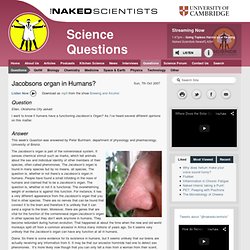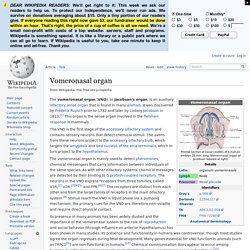

Jacobsons organ in Humans? - The Naked Scientists October 2007. Listen Now Download as mp3 from the show Brewing and Alcohol Question Ellen, Oklahoma City asked: I want to know if humans have a functioning Jacobson’s Organ?

As I’ve heard several different opinions on this matter. Answer This week's Question was answered by Peter Burnham, department of physiology and pharmacology, University of Bristol. The Jacobson’s organ is part of the vomeronasal system. Diana: So there is some evidence for its existence in humans, but it seems unlikely that our brains are actually receiving any information from it. What is the Jacobson's Organ? Jacobson's Organ and the Sixth Sense. Traditionally humans have been thought to come equipped with five senses: sight, hearing, taste, touch, and smell.

Animals possess several extra senses, including altered vision and hearing, echolocation, electric and/or magnetic field detection, and supplementary chemical detection senses. In addition to taste and smell, most vertebrates use Jacobson's organ (also termed the vomeronasal organ and vomeronasal pit) to detect trace quantities of chemicals. While snakes and other reptiles flick substances into Jacobson's organ with their tongues, several mammals (e.g., cats) exhibit the Flehmen reaction. When 'Flehmening', an animal appears to sneer as it curls its upper lip to better expose the twin vomeronasal organs for chemical sensing. In mammals, Jacobson's organ is used not simply to identify minute quantities of chemicals, but also for subtle communication between other members of the same species, through the emission and reception of chemical signals called pheromones.
Vomeronasal organ. The vomeronasal organ (VNO), or Jacobson's organ, is an auxiliary olfactory sense organ that is found in many animals.

It was discovered by Frederik Ruysch prior to 1732 and later by Ludwig Jacobson in 1813.[1] This organ is the sense organ involved in the flehmen response in mammals. The VNO is the first stage of the accessory olfactory system and contains sensory neurons that detect chemical stimuli. The axons from these neurons project to the accessory olfactory bulb, which targets the amygdala and bed nucleus of the stria terminalis, which in turn project to the hypothalamus. The vomeronasal organ is mainly used to detect pheromones, chemical messengers that carry information between individuals of the same species.
As with other olfactory systems, chemical messages are detected by their binding to G protein-coupled receptors. Structure[edit] Placement of Jacobson's organ in a snake Function[edit]